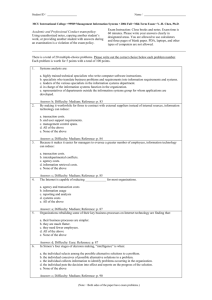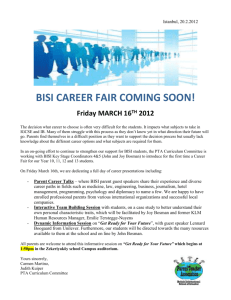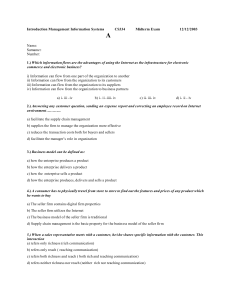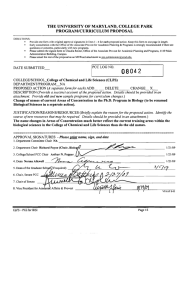Quiz 1-4
advertisement
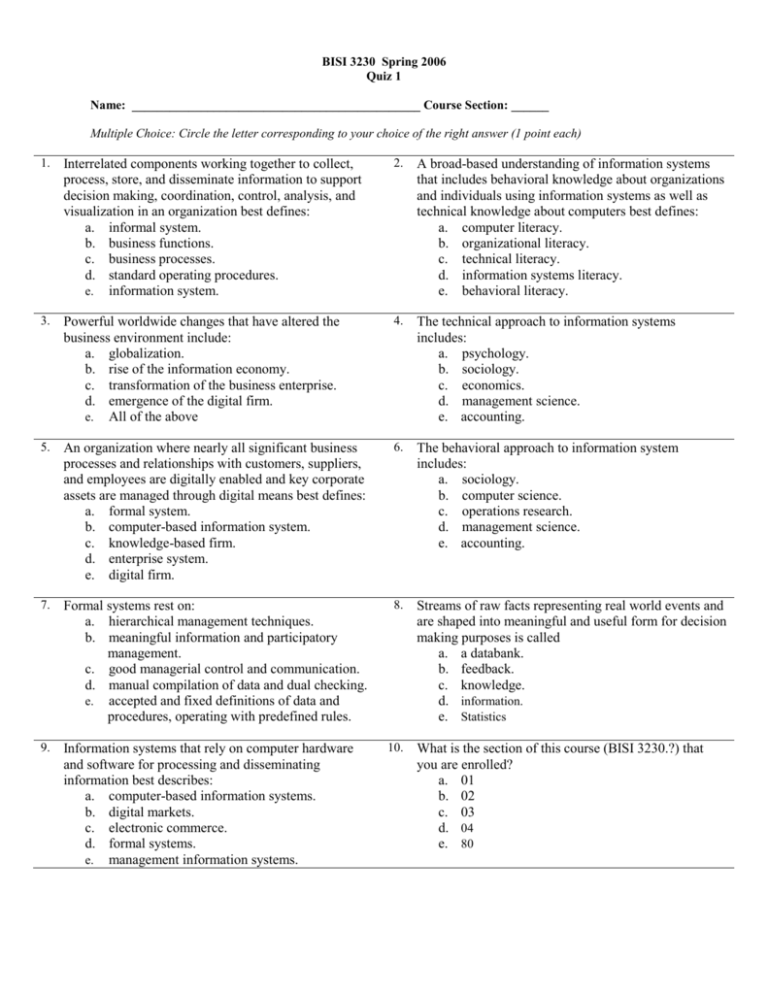
BISI 3230 Spring 2006 Quiz 1 Name: ______________________________________________ Course Section: ______ Multiple Choice: Circle the letter corresponding to your choice of the right answer (1 point each) 1. Interrelated components working together to collect, process, store, and disseminate information to support decision making, coordination, control, analysis, and visualization in an organization best defines: a. informal system. b. business functions. c. business processes. d. standard operating procedures. e. information system. 2. A broad-based understanding of information systems that includes behavioral knowledge about organizations and individuals using information systems as well as technical knowledge about computers best defines: a. computer literacy. b. organizational literacy. c. technical literacy. d. information systems literacy. e. behavioral literacy. 3. Powerful worldwide changes that have altered the business environment include: a. globalization. b. rise of the information economy. c. transformation of the business enterprise. d. emergence of the digital firm. e. All of the above 4. The technical approach to information systems includes: a. psychology. b. sociology. c. economics. d. management science. e. accounting. 5. An organization where nearly all significant business processes and relationships with customers, suppliers, and employees are digitally enabled and key corporate assets are managed through digital means best defines: a. formal system. b. computer-based information system. c. knowledge-based firm. d. enterprise system. e. digital firm. 6. The behavioral approach to information system includes: a. sociology. b. computer science. c. operations research. d. management science. e. accounting. 7. Formal systems rest on: a. hierarchical management techniques. b. meaningful information and participatory management. c. good managerial control and communication. d. manual compilation of data and dual checking. e. accepted and fixed definitions of data and procedures, operating with predefined rules. 8. Streams of raw facts representing real world events and are shaped into meaningful and useful form for decision making purposes is called a. a databank. b. feedback. c. knowledge. d. information. e. Statistics 9. Information systems that rely on computer hardware and software for processing and disseminating information best describes: a. computer-based information systems. b. digital markets. c. electronic commerce. d. formal systems. e. management information systems. 10. What is the section of this course (BISI 3230.?) that you are enrolled? a. 01 b. 02 c. 03 d. 04 e. 80 BISI 3230 Spring 2006 Quiz 2 Name: ______________________________________________ Course Section: ___ 1. Information systems can be defined by organizational level and: a. organizational function. b. the cost of equipment and training. c. the educational requirements needed to use them. d. analytical reporting ability. e. user support functions. 2. Transaction processing systems (TPS) operate at the: a. management level. b. strategic level. c. decision-support level. d. operational level. e. knowledge level. 3. Operational-level systems: a. monitor the elementary activities and transactions of the organization. b. support knowledge and data workers in an organization. c. support the monitoring, controlling, decisionmaking and administrative activities of middle management. d. support long-range planning activities. e. support financial and resource planning activities. 4. An example of an operational-level system is: a. one to record the number of hours worked each day by employees on the factory floor. b. CAD. c. decisions about the design of future products. d. reports where sales fall below anticipated levels by territory. e. All of the above. 5. Which of the following types of users are characteristic of an ESS? a. Operations personnel; supervisors b. Middle managers c. Professionals; staff managers d. Senior managers e. Customers 6. Which of the following is not a major functional category of TPS? a. Sales/marketing b. Manufacturing/production c. Finance/accounting d. Human resources e. Economics 7. Information systems at the organization’s management level that combine data and sophisticated analytical models or data analysis tools to support semistructured and unstructured decision making best describes: a. management information systems. b. artificial intelligence systems. c. transaction processing systems. d. executive support systems. e. decision support systems 8. Finance and accounting systems keep track of: a. manpower requirements for meeting long-term business plans. b. financial assets and fund flows. c. supply chain and computer resource management. d. financial information external to the firm. e. sales records. 9. Forms of global business organization include: a. multinationals. b. franchisers. c. transnationals. d. domestic exporters. e. All of the above 10. A company that controls finances in the home country and decentralizes production, sales, and marketing operations to other countries is using: a. the domestic exporter strategy. b. the transnational strategy. c. the multinational strategy. d. the franchising strategy. e. None of the above BISI 3230 Spring 2006 Quiz 3 Name: ______________________________________________ Course Section: ___ 1. The interaction between information technology and organizations is influenced by: a. organizational structure. b. standard operating procedures. c. politics and culture. d. environment and management decisions. e. All of the above 2. According to Weber, bureaucracies are prevalent because: a. they are impartial. b. authority is limited by abstract rules. c. they are the most efficient form of organization. d. they develop standard operating procedures. e. people are most comfortable with the expected. 3. Which of the following is an example of a professional bureaucracy? a. Fortune 500 firm b. School system c. Midsize manufacturing firm d. Small start-up business e. Consulting firm 4. CIOs are: a. highly-trained technical specialists who write computer software instructions. b. specialists who translate business problems and requirements into information requirements and systems. c. leaders of the various specialists in the information systems department. d. in charge of the information systems function in the firm. e. representatives of departments outside the information systems group for whom applications are developed. 5. By making it worthwhile for firms to contract with external suppliers instead of internal sources, information technology can reduce: a. transaction costs. b. end user support requirements. c. management control spans. d. All of the above e. None of the above 6. Because it makes it easier for managers to oversee a greater number of employees, information technology can reduce: a. transaction costs. b. interdepartmental conflicts. c. agency costs. d. information retrieval costs. e. None of the above 7. ___________________ roles are descriptions of situations wherein managers act as figureheads and leaders for the organization. a. behavioral b. Informational c. Interpersonal d. Managerial e. Agency 8. The view that firms grow larger because they can conduct marketplace transactions internally more cheaply than they can with external firms in the market place is called the: a. agency theory. b. virtual organization theory. c. informational access theory. d. transaction cost theory. e. internal business transaction theory. 9. The act of defining the long-term objectives, resources, and policies of an organization is called: a. structured decision-making. b. management. c. policy. d. strategic decision-making. e. operations. 10. A(n) _________ decision is a nonroutine decision in which the decision maker must provide judgment, evaluation, and insights into the problem definition. a. structured b. unstructured. c. policy. d. political. e. operations. BISI 3230 Quiz 4 Spring 2006 Name: ______________________________ Section:___________________ 1. The Internet shrinks: a. survival potential in banks. b. symmetrical relationships between businesses. c. information asymmetry. d. time and money factors in financing. e. the size of established companies. 2. A measurement of the depth and detail of information that a business can supply to the customer as well as information the business collects about the customer best defines: a. reach. b. intensity. c. micromarketing. d. richness. e. channel leveling. 3. A measurement of how many people a business can connect with and how many products it can offer those people best defines: a. reach. b. intensity. c. micromarketing. d. richness. e. channel descriptor. 4. Which of the following Internet business models provides a digital environment where buyers and sellers can meet, search for products, display products, and establish prices for those products? a. Portal b. Virtual community c. Online marketplace d. Transaction broker e. Online service provider 5. eBay is an example of: a. a click-and-mortar business. b. consumer-to-consumer electronic commerce. c. business-to-consumer electronic commerce. d. an online community. e. online syndication. 6. Consumers selling goods and services electronically to other consumers best describes: a. disintermediation. b. consumer-to-consumer electronic commerce. c. mobile commerce. d. business-to-consumer electronic commerce. e. consumer networking. 7. A system that enables users to make micropayments and purchases on the Web by accumulating a debit balance on their credit card or telephone bill best describes: a. smart card. b. accumulated balance payment system. c. accumulated deferral system. d. digital cash. e. peer-to-peer payment system. 8. The removal of organizations or business process layers responsible for certain intermediary steps in a value chain is called: a. disintermediation. b. reintermediation. c. customer self-service. d. pure-play. e. dynamic provision. 9. The shifting of the intermediary role in a value chain to a new source is called: a. disintermediation. b. reentrance. c. reintermediation. d. intermediary relocation. 10. Which of the following is not a major e-commerce category? a. B2B b. B2C c. C2C d. S2B e. all of the above e. distributor displacement.
